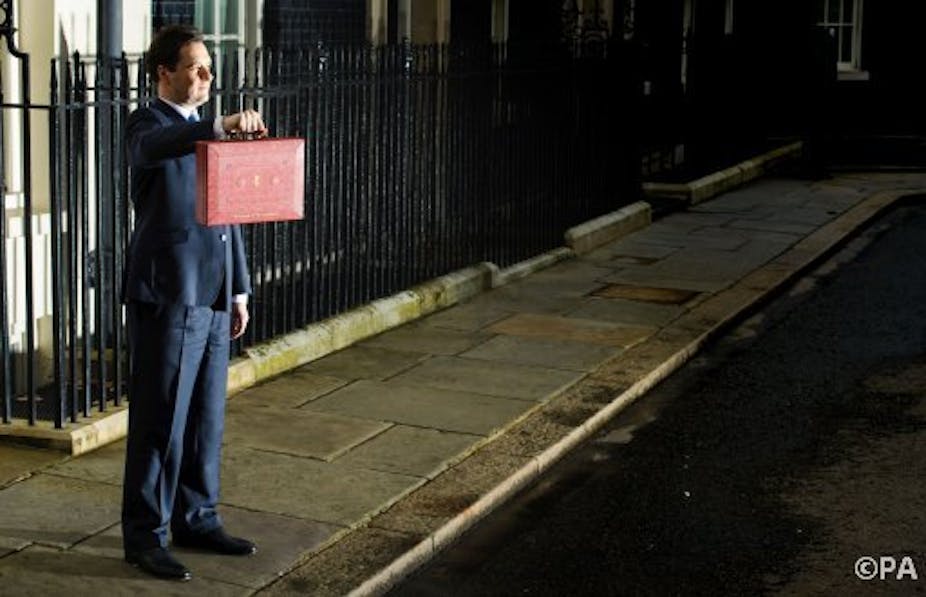George Osborne’s announcement this week that a Conservative government would implement £25 billion of cuts over two years after the next election is a bold statement of intent both economically and politically. The speech put clear blue water between the Conservatives and their current Liberal Democrat coalition partners, and Nick Clegg being unusually forthright in his criticism of the proposals, going so far as to call them a “monumental mistake”. Iain Duncan Smith, meanwhile, complained publicly that the chancellor is “hacking away at the same people” – exposing toxic disagreements in the cabinet over how and why to cut welfare spending.
But in terms of their general principles, and even specific proposals, Osborne’s latest plans are really nothing new – and for all the political heat they’ve generated, their details remain sketchy.
In their scale, the proposed cuts reflect the plans Osborne set out in his December 2013 autumn statement, in which he sought to achieve a budget surplus by 2018/19. The specific policy proposals have also been trailed before. Economically Osborne remains committed to continued austerity, with deficit reduction to be achieved by expenditure cuts (focused on parts of the welfare budget) rather than tax rises (indeed, he signalled a desire to cut tax rates in the future).
It has not gone unnoticed that pensioners seem to have been spared, with the announced “triple lock” protection of the state pension and indications that other pensioner benefits would not be targeted. Instead, many of the indicated cuts to welfare would fall on 16-25 year olds – a banner proposal at this year’s Tory party conference.
Whilst the proposed £25 billion cuts are consistent with earlier austerity plans in broad terms, the Chancellor has given himself limited room for manoeuvre. With pensioner benefits protected and departmental spending on health, schools and aid ring-fenced, the proposed cuts to welfare become central to Osborne’s strategy: hence, the chancellor has announced that £12bn of these cuts would come from the welfare budget.
Although the chancellor plans to eliminate the budget deficit by 2018/19, expenditure is not forecast to change in real terms within this government’s term. However, welfare payments and interest payments on the growing national debt are forecast to rise, particularly with expected rises in the interest rates the government will have to pay on this debt. With key areas like education ring-fenced and others politically sacrosanct (it is, for example, hard to imagine a Conservative government implementing further major cuts to the defence budget), welfare is the obvious target.
The basic state pension accounts for around £75bn of the £180bn spent on benefits each year; with this protected, the chancellor’s plan is set on targeting housing and other benefits to the under-25s, restricting (non-pension) benefits to rise by no more than wages if wages continue to rise more slowly than prices, and further restricting eligibility for various benefits. Meanwhile, it is worth noting that the state pension is not, on government forecasts, likely to rise in real terms.
But the specific measures indicated so far would only amount to a fraction of the £12 billion cuts envisaged, perhaps around £2 billion. And while the intentions of the statement are clear, the details of how it would have to be enacted are still sparse. This austere New Year message means whoever is in power after the next election will face tough choices – and that necessarily applies to Osborne himself. In his last budget and autumn statement, the chancellor set out a plan to eliminate the budget deficit over the term of the next parliament, and reiterated in this announcement – but if cuts in the welfare budget on the chancellor’s required scale are to be achieved, they will have to go far beyond those floated so far.
These cuts will hit not just the economically active, but also those who are both in work and in receipt of benefits. With ring-fencing in force, departmental cuts are likely to fall on areas such as the Home Office (including policing), local government, and transport, departments that have already borne the brunt of this parliament’s cutbacks. Alternatively, taxes would have to rise (as the Liberal Democrats now appear to advocate) or the timetable for eliminating the budget would have to be pushed back further – in practice quite likely, but politically taboo.
It is not just the detailed question of how the proposed cuts would be achieved; eliminating the deficit requires the economy to grow in line with forecasts to generate the projected tax receipts. There are grounds for optimism here, with rising consumer confidence and encouraging indicators from manufacturing. But the projections require strong recoveries in investment and exports, whilst consumer confidence remains vulnerable to any rise in interest rates.
The chancellor is right that the next government will face hard choices – but if he wants to achieve the scale of cuts he envisages, he must make some specific ones, too.

